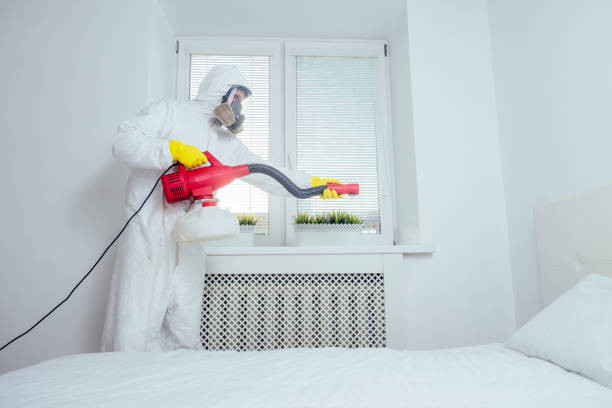Winter does not stop bed bugs; it changes where and how homeowners and businesses encounter them, and understanding that shift is the first step toward prevention and control. This article explains why bed bugs remain a winter risk in Florence, SC, how their survival strategy affects detection, the signs to watch for in cold months, and practical prevention steps you can take right away. You will also find guidance on when DIY tactics are appropriate and when professional intervention is the safer, more effective choice. Finally, the piece outlines what Southern Perimeter Pest Pros offers for winter bed bug control and how to schedule a free inspection to confirm an infestation and evaluate treatment options. Read on to learn actionable winter-specific prevention advice, how to spot hidden infestations, and the benefits of targeted services such as bed bug heat treatment in Florence, SC.
Why Are Bed Bugs a Winter Risk in Florence, SC?
Bed bugs remain a winter risk because they seek indoor refuges where they can access human hosts and stable temperatures, and they can enter a dormant state called diapause that reduces activity and detection. In Florence, SC, indoor crowding, winter travel, and the movement of second-hand furniture create opportunities for indoor aggregation and spread, so cold weather rarely eliminates the problem. Understanding these mechanisms helps prioritize inspections and storage practices that reduce introductions and early establishment. The next subsections explain how diapause works and whether winter truly increases infestation likelihood.
How Do Bed Bugs Survive Cold Weather and Enter Diapause?
Diapause is a physiological dormancy that allows bed bugs to slow metabolism and survive extended periods with reduced feeding, which makes them harder to detect during winter months. This survival strategy does not mean bed bugs are immune to cold, but it does let them persist in heated indoor environments or insulated furnishings for weeks to months without regular feeding. Recent pest management guidance highlights that diapause complicates visual detection and can delay recognition until population rebound occurs in warmer microclimates. Recognizing diapause underscores the need for careful inspection of warm, occupied spaces where dormant populations can persist undetected.
Does Winter Increase the Chance of Bed Bug Infestations?
Winter can indirectly increase infestation chances because more time indoors, holiday and business travel, and seasonal second-hand shopping raise introduction pathways even as bugs are less active. Contrary to the myth that cold kills bed bugs outdoors, indoor heating preserves survivable conditions and human hosts, so infestation rates can remain steady or even grow in winter settings. A practical example is a visiting guest or used furniture bringing a few bed bugs into an otherwise clean home; those few can multiply unseen while in diapause. Knowing that winter changes detection rather than eliminating risk helps homeowners focus on prevention and early inspection.
What Are the Signs of Bed Bug Infestation During Winter?
Detecting bed bugs in winter requires attention to both direct evidence and secondary indicators because low activity makes sightings less common. Key signs include bite patterns, small dark fecal spots on fabrics, shed skins, and occasional live bugs or odors in severe infestations; these clues are often concentrated where people sleep and where warm clothing or luggage are stored. Regular checks of bedding, upholstered furniture, and coat storage areas reveal many early infestations before they spread widely.
Common Signs of a Bed Bug Infestation
Bite marks: Small, clustered bites that may itch or appear overnight.
Where to look: On exposed skin after sleep or in bedding.
Fecal spots: Tiny dark spots that resemble pepper flakes or ink dots.
Where to look: Mattress seams, box springs, and upholstered furniture.
Shed skins or eggs: Pale shed skins and tiny white eggs may indicate active breeding.
Where to look: In mattress seams, crevices, or behind baseboards.
Live bugs: Occasionally, adult bed bugs or nymphs may be seen.
Where to look: Mattress folds, luggage, or clothing pockets.
Quick inspections focused on these locations increase the chance of early detection, and the next subsection explains bite identification in more detail.
How to Identify Bed Bug Bites and Physical Signs in Winter Homes
Bed bug bites often appear in linear or clustered patterns and may not develop immediately, making them less reliable as a sole indicator during winter when exposure and circulation change. Physical signs such as fecal spots, shed skins, and rust-colored smears on mattresses provide stronger confirmation because they persist whether bugs are active or in diapause. Photographing bites and documenting fabric spots helps technicians evaluate whether professional inspection is warranted, especially if multiple signs co-occur. When physical evidence is ambiguous, a professional inspection can confirm presence through targeted tools and knowledge of typical harborage points.
Where to Look for Bed Bug Evidence in Winter Conditions
Prioritize sleeping areas and places where winter clothing, luggage, or donated furniture are stored, because these warm, protected spots are preferred by hiding bed bugs during cold months. Inspect mattress seams, bed frames, box springs, upholstered seating, curtain folds, and behind baseboards, then extend checks to closets, coat pockets, and storage boxes where winter garments accumulate. Use a flashlight and a hard card to probe seams and crevices; consistent findings across multiple surfaces strongly suggest infestation. Regular, methodical checks in these locations reduce the chance that dormant populations remain unnoticed until they expand.
How Can Homeowners and Businesses Prevent Bed Bugs in Winter?
Prevention in winter focuses on reducing introduction pathways and increasing early detection through targeted routines and storage habits that limit suitable refuges for bed bugs. Effective measures include laundering clothing and luggage promptly after travel using high heat, encasing mattresses and box springs, minimizing clutter, and carefully inspecting any second-hand items before bringing them indoors. These steps create a layered defense that lowers the likelihood of a small introduction turning into a persistent infestation. After the practical DIY tips below, a comparison table clarifies when professional services provide superior outcomes.
Practical prevention steps to apply immediately:
Inspect and vacuum luggage and outerwear after travel to remove hitchhiking insects.
Wash and heat-dry clothing and bedding at the highest safe temperature after potential exposure.
Use mattress and box spring encasements to create a barrier against hiding bed bugs.
Carefully inspect and isolate second-hand furniture and donate or dispose of questionable items.
Reduce clutter and seal cracks where bed bugs can hide, especially in heated rooms.
These steps are achievable by most households, but they have limits when infestations are hidden or widespread, as outlined next.
Approaches to Managing Bed Bugs in Winter
DIY laundering and encasements: Offers moderate effectiveness for small infestations.
Winter suitability: Good for immediate prevention and maintenance.
Vacuuming and inspection: Effectiveness depends on detection skills and thoroughness.
Winter suitability: Useful but may miss dormant (diapause) populations.
Professional inspection and treatment: Highly effective, especially when evidence is limited or infestation is unclear.
Winter suitability: Best option for dormant or widespread infestations.
When DIY measures fall short—for example, when signs persist despite prevention—professional inspection and targeted control become necessary to fully eradicate bed bugs and prevent spread.
What DIY Winter Bed Bug Prevention Tips Are Effective?
DIY measures are most effective at prevention and early containment: frequent laundering and heat-drying of textiles, routine inspection of luggage and winter outerwear, and using mattress encasements to reduce suitable habitats and remove hitchhiking insects. Vacuuming seams and edges and reducing clutter make visual inspections more productive and lower hiding places for small populations. However, tools like over-the-counter sprays or inconsistent heat exposure often fail to reach eggs and deeply hidden nymphs, so DIY is a first line rather than a guaranteed cure. Understanding these limits helps homeowners decide when to escalate to professional services.
Why Is Professional Bed Bug Extermination Recommended in Winter?
Professionals provide specialized inspection tools and knowledge to detect low-activity or dormant infestations that DIY checks miss, and they can offer heat treatment that reliably kills all life stages regardless of diapause. Professional approaches include documented inspection, tailored treatment plans, and follow-up monitoring to reduce recurrence, which is especially valuable in winter when bugs are less visible. Some providers emphasize heat treatment because it penetrates luggage, mattresses, and crevices without reliance on prolonged chemical exposure. For situations with multiple signs or repeated problems, calling a professional reduces the risk of ineffective DIY attempts and recurring infestations.
What Does Southern Perimeter Pest Pros Offer for Winter Bed Bug Control in Florence, SC?
Southern Perimeter Pest Pros provides winter bed bug services focused on prompt inspection, accurate identification, and thorough eradication to restore safe indoor environments in Florence, SC. The company's approach follows a three-step process—inspection, identification, eradication—with free inspections offered to confirm infestations and recommend the best course of action. Heat treatment is highlighted as an effective winter solution because it neutralizes all life stages and works independently of outdoor temperatures, making it especially suitable for cold-weather eradication.
Pest Control Process Overview
Inspection:
A detailed visual and tool-assisted assessment is performed.
Note: A free inspection is offered to confirm the presence of pests.Identification:
The team confirms the pest species and the extent of the infestation.
Note: Assessments are performed by specialist-trained technicians.Eradication:
Targeted treatments, including heat options, are applied to eliminate pests.
Note: Heat treatment is available, and follow-up monitoring is included.
These services aim to move households from uncertainty to documented control swiftly, and scheduling a free inspection is the natural next step when signs suggest a winter infestation.
How Does Southern Perimeter’s Three-Step Bed Bug Prevention Process Work?
The inspection begins with a room-by-room visual survey and targeted probes of likely hiding places, documenting findings and advising on immediate containment steps. Identification uses technician expertise to differentiate bed bugs from other pests and to map infestation scope, which guides an evidence-based treatment plan. Eradication employs appropriate methods—often heat treatment in winter—to reach all life stages followed by monitoring to confirm success and prevent rebound. Customers receive clear documentation of findings and recommended next steps so they understand the rationale for any proposed treatment.
What Are the Benefits of Professional Heat Treatment for Winter Bed Bug Control?
Professional heat treatment raises indoor temperatures to levels lethal to bed bugs at all life stages, offering a chemical-minimizing approach that is effective regardless of outside weather. Benefits include rapid treatment time, deep penetration into mattresses and luggage, and a high probability of complete population elimination when properly applied. Preparatory steps and access considerations are discussed during inspection so homeowners know what to expect and how to prepare living spaces. For winter conditions, heat treatment’s independence from outdoor temperatures makes it especially reliable.How Can You Schedule a Free Winter Bed Bug Inspection with Southern Perimeter Pest Pros?
Scheduling a free inspection is a straightforward way to confirm whether winter signs indicate an active infestation and to get a recommended treatment plan tailored to your situation in Florence, SC. The inspection includes a thorough assessment of sleeping areas, storage where winter clothing is kept, and likely harborage points, with documentation and a clear outline of treatment options provided afterward. For immediate assistance or to arrange an appointment, contact Southern Perimeter Pest Pros by phone at (843) 601-2791 or by using the company’s online contact options noted in its local listings. The next H3 explains what to expect during an inspection appointment.
What to Expect During Your Winter Bed Bug Inspection Appointment
Expect a discrete, focused visit where a technician spends time inspecting bedding, furniture, baseboards, and storage areas, typically documenting evidence and making immediate recommendations for containment. Inspections commonly take 30–60 minutes depending on property size, and technicians may suggest simple preparatory steps to preserve evidence or ready areas for potential treatment. You will receive clear notes on what was found, the recommended next steps, and an explanation of available treatment options including heat treatment when appropriate. This transparent process reduces uncertainty and helps homeowners choose the best path forward.




